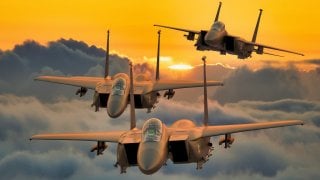F-15E Strike Eagle: Dominating the Skies with Unmatched Firepower
The F-15E variant of the McDonnell-Douglas/Boeing F-15 warplane is a testament to the evolution of air combat technology. Introduced as an advancement over its predecessors, the F-15E was designed for both air-to-air combat and air-to-ground attack, featuring a two-crew configuration for enhanced operational capabilities.
Summary: The F-15E variant of the McDonnell-Douglas/Boeing F-15 warplane is a testament to the evolution of air combat technology. Introduced as an advancement over its predecessors, the F-15E was designed for both air-to-air combat and air-to-ground attack, featuring a two-crew configuration for enhanced operational capabilities. It embodies the leap into the computer age with a central computer, laser gyro, GPS for precise navigation, an advanced APG-70 radar system, and the innovative LANTIRN system for low-altitude, night-time precision strikes. With an impressive 3,500-mile range, Mach 2.5 speed, and the capacity to carry 23,000 pounds of ordnance, the F-15E boasts a 104 to 0 dogfight record, emphasizing its dominance.
The F-15E Strike Eagle: Not Just Another Fighter Jet
The US Air Force’s McDonnell-Douglas/Boeing F-15 warplane is a well-known fourth-generation fighter. Having first gone into service in 1974, the plane has become a workhorse of the USAF. It was originally designed as an air-to-air fighter, and it still fills that role today. Although, a newer variant, the F-15E, was introduced to add a new capability onto the Air Force’s fourth-generation workhorse: air-to-ground attack. Along with that new capability came an additional crewmember, a weapons system officer (most F-15 variants, other than the “C” model are two-seaters).
Together, the pilot and weapons system officer (WSO) can fight through whatever anti-aircraft defenses are deployed around a ground target or they can dogfight any other enemy warplane sent to attack them.
F-15E: A Warplane for the Computer Age
The F-15E was an advancement ready-made for the computer age.
A central computer ties all functions of this craft together (of course, it is not as advanced as the computer suites that run the F-22A Raptor or the F-35 Lightning II). A laser gyro and the Global Positioning System (GPS) provide constant updates on its position to the central computer, which then enhances situational awareness for the pilot and his weapons officer by giving an up-to-date, sophisticated digital map of the ground below.
This increases the lethality of the warplane as well as better protects the two airmen onboard. The warbird possesses an advanced APG-70 radar system that allows for the crew to identify threats and/or targets at longer-ranges than other warplanes.
Again, the F-15E was a major improvement upon what came before because of another innovative system that was put onboard this variant. That is the Low-Altitude Navigation and Targeting Infrared for Night (LANTIRN) system. With LANTIRN active, the F-15E can buzz about at extremely low-altitudes, in inclement weather—at night, if need be—and hit ground targets with a variety of precision-guided munitions.
The lethality of this bird cannot be understated.
There is a navigation pod that has terrain-following radar of the sort that made the F-111 Aardvark so lethal in combat. Unlike the Aardvark, however, the terrain-following radar can be tied to the F-15E’s autopilot, allowing for a hands-free piloting experience. If the bird is on a long-haul flight, this would give the pilot considerable time to rest or perform other tasks, amplifying the pilot’s efficiency while in air.
The F-15E is a High-Intensity/High-Endurance Beast
Beyond these technical specifications, the F-15E variant has an astonishing 3,500-mile range. This bird also has some hustle. She can reach Mach 2.5. In essence, the plane is known for its versatility, its maneuverability, and its ability to operate in hostile, contested environments.
The warbird can carry 23,000 pounds of destruction, too.
Speaking of destruction and versatility, the F-15 model has never lost a dogfight. It’s current record over adversaries is 104 to 0. The Navy’s iconic F-14 Tomcat (made famous by Tom Cruise in the original Top Gun) has 135 kills (not included the MiG that Maverick downed in the famous 1980s Cold War caper), but it’s been downed four times. The F-16, the Air Force’s supposedly superior, next-level warplane to the F-15, has 76 kills and one loss in air-to-air combat.
As an addendum to the whole need-for-speed thing, the F-15E, like all the F-15 models, is not only the fastest warplane in the US military’s arsenal, but she has the most powerful—and fastest—vertical thrust. It’s so great that in 1985, USAF Major Wilbert “Doug” Pearson took his F-15A, the original variant of the F-15, to high-altitudes and fired an anti-satellite (ASAT) missile into low-Earth orbit (LEO). That missile destroyed a derelict satellite in a proof-of-concept attack. So, the F-15—including the F-15E—is also a starfighter.
The F-15E was an astonishingly excellent enhancement for an already storied warplane. The F-15 has been in service for more than 50 years. It has multiple variants. And it continues to break all kinds of records. Despite this, the Air Force had plans to replace these incredible war machines with its much-ballyhooed fifth-generation warplanes, the F-22A Raptor and the F-35 Lighting II.
Even after the F-22A was canceled in 2009, the Air Force remained committed to ridding itself of the F-15 in favor of a fifth-generation warplane.
The Air Force Just Can’t Quit the F-15
Despite its best efforts, though, the Air Force just cannot seem to quit the F-15. After all, they went out and designed an entirely new variant—the F-15EX Eagle II—which I described in an earlier essay as a “flying missile truck.” The F-15 might not have the accoutrements that the F-22 or the F-35 has. And they might ultimately be felled by Chinese or Russian fifth-generation warplanes.
But, for 50 years, despite what their detractors have argued, these planes have ruled the skies and been a staple of the US Air Force’s air fleet. Even now, the F-15 keeps getting updated rather than retired, despite the new F-15EX Eagle IIs being more expensive than the F-35!
This is a warplane that will forever be remembered for its marvelous engineer and advanced technical prowess in combat.
About the Author
Brandon J. Weichert is a former Congressional staffer and geopolitical analyst who is a contributor at The Washington Times, as well as at American Greatness and the Asia Times. He is the author of Winning Space: How America Remains a Superpower (Republic Book Publishers), Biohacked: China’s Race to Control Life, and The Shadow War: Iran’s Quest for Supremacy. Weichert can be followed via Twitter @WeTheBrandon.


